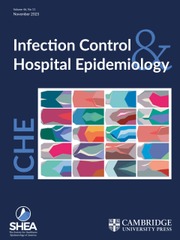No CrossRef data available.
Article contents
Patient safety as a measure of resilience in US hospitals: central line-associated bloodstream infections, July 2020 through June 2021
Published online by Cambridge University Press: 14 February 2025
Abstract
Resilience of the healthcare system has been described as the ability to absorb, adapt, and respond to stress while maintaining the provision of safe patient care. We quantified the impact that stressors associated with the COVID-19 pandemic had on patient safety, as measured by central line-associated bloodstream infections (CLABSIs) reported to the Centers for Disease Control and Prevention’s National Healthcare Safety Network.
Acute care hospitals were mandated to report markers of resource availability (staffing and hospital occupancy with COVID-19 inpatients) to the federal government between July 2020 and June 2021. These data were used with community levels of COVID-19 to develop a statistical model to assess factors influencing rates of CLABSIs among inpatients during the pandemic.
After risk adjustment for hospital characteristics, measured stressors were associated with increased CLABSIs. Staff shortages for more than 10% of days per month were associated with a statistically significant increase of 2 CLABSIs per 10,000 central line days versus hospitals reporting staff shortages of less than 10% of days per month. CLABSIs increased with a higher inpatient COVID-19 occupancy rate; when COVID-19 occupancy was 20% or more, there were 5 more CLABSIs per 10,000 central line days versus the referent (less than 5%).
Reporting of data pertaining to hospital operations during the COVID-19 pandemic afforded an opportunity to evaluate resilience of US hospitals. We demonstrate how the stressors of staffing shortages and high numbers of patients with COVID-19 negatively impacted patient safety, demonstrating poor resilience. Understanding stress in hospitals may allow for the development of policies that support resilience and drive safe care.
- Type
- Original Article
- Information
- Creative Commons
- This is a work of the US Government and is not subject to copyright protection within the United States. To the extent this work is subject to copyright outside of the United States, such copyright shall be assigned to the US Government and licensed to the Publisher. Outside of the US, the US Government retains a paid-up, non-exclusive, irrevocable worldwide licence to reproduce, prepare derivative works, distribute copies to the public and display publicly the Contribution, and to permit others to do so. Published by Cambridge University Press on behalf of The Society for Healthcare Epidemiology of America.
- Copyright
- © US Government, 2025



